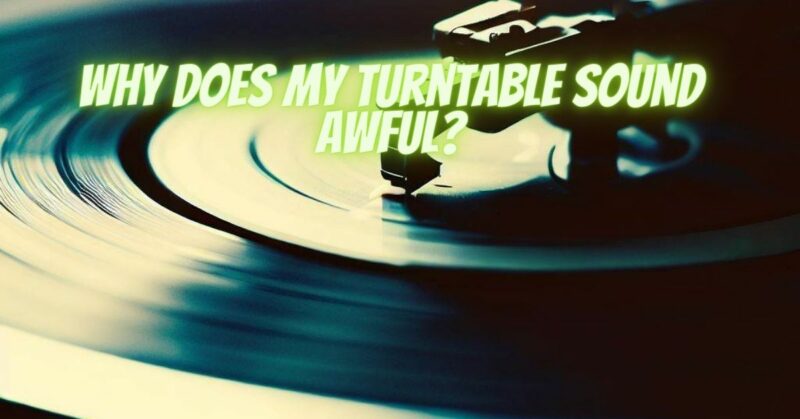As a vinyl enthusiast, there’s nothing more disheartening than experiencing subpar sound quality from your turntable. If you find yourself asking, “Why does my turntable sound awful?” fear not! In this article, we will explore common reasons behind poor turntable sound quality and provide practical solutions to help you restore the full potential of your vinyl playback.
- Misaligned Cartridge and Stylus: One of the primary culprits behind poor sound quality is a misaligned cartridge and stylus. A misaligned setup can result in tracking errors, distortion, and overall degradation of sound. Ensure that your cartridge and stylus are properly aligned following the manufacturer’s guidelines or seek professional assistance for accurate alignment.
- Dirty or Worn-out Stylus: A dirty or worn-out stylus can wreak havoc on your sound quality. Dust, debris, and accumulated dirt can affect the stylus’s ability to accurately read the record grooves, leading to muffled or distorted sound. Regularly clean your stylus with a stylus brush or invest in a stylus cleaning kit. If your stylus is worn out, consider replacing it for optimal sound reproduction.
- Poor Record Condition: Vinyl records are susceptible to wear, scratches, and dust accumulation over time. A poorly maintained or damaged record can result in clicks, pops, and distorted sound. Clean your records using appropriate record cleaning methods, store them in protective sleeves, and handle them with care to preserve their condition and maintain excellent sound quality.
- Incorrect Turntable Setup: Improper turntable setup can have a significant impact on sound quality. Ensure the following setup parameters are correctly configured: a. Tonearm balance: Improper balance can result in uneven tracking and distorted sound. Adjust the tonearm balance according to the manufacturer’s instructions for optimal performance. b. Vertical tracking angle (VTA): Incorrect VTA can affect the alignment between the stylus and the record grooves, resulting in compromised sound quality. Adjust the VTA to achieve the best alignment for your cartridge.
- Inadequate Tracking Force: Insufficient tracking force can cause the stylus to skip or skate across the record surface, resulting in distorted sound or even skipping tracks altogether. Consult your turntable’s manual or cartridge specifications to ensure the correct tracking force is applied for optimal performance.
- Poor Grounding and Connection Issues: Electrical interference and connection problems can introduce unwanted noise and affect sound quality. Ensure that your turntable’s grounding wire is properly connected to your amplifier or receiver. Check all cable connections and ensure they are secure and free from damage.
- Insufficient Amplification: If your turntable is not delivering enough volume or lacks clarity, the issue may lie with your amplifier or receiver. Ensure that your amplifier has a dedicated phono input or use an external phono preamp to properly amplify the turntable’s signal.
Conclusion:
Identifying and addressing the reasons behind poor turntable sound quality can help you restore the authentic, rich sound experience that vinyl records offer. From proper cartridge alignment and stylus maintenance to ensuring correct turntable setup and addressing grounding or connection issues, these solutions will help you overcome common sound quality problems. Embrace the beauty of vinyl with exceptional sound reproduction, and let your turntable bring your music collection back to life with its true sonic potential.


